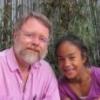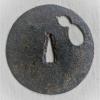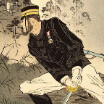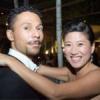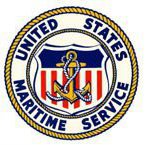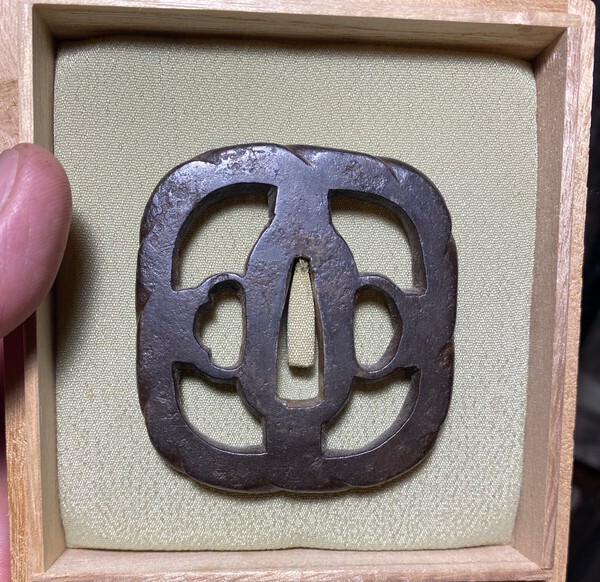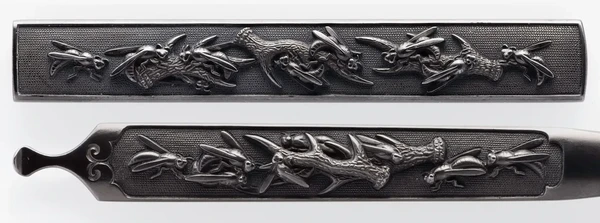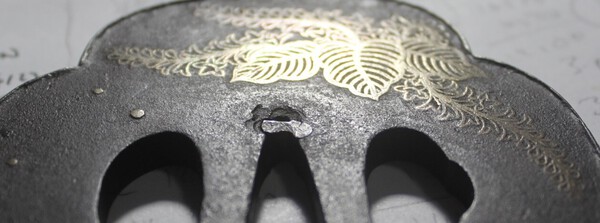Leaderboard
Popular Content
Showing content with the highest reputation on 01/07/2025 in all areas
-
I recently found a "stash" of difficult to find tsuba linked to the Ashmolean Museum - through their ASHMOLEAN IMAGE LIBRARY - This added something in the order of 160 more tsuba to the 1,800 odd other tsuba that can be found in the museum searches https://www.ashmolean.org/collections-online#/search/simple-search/tsuba/%7B%7D/15/96/objectNumberSortedSorting1.keyword/asc/catalogue I was taken by a particularly designed piece based on an expanded "Three Karigane" sukashi pattern - which had five birds rather than the more common three - however the description stated the design was "Ginkgo Leaves" So I thought I would let the museum know they had the wrong description. I realise that the link now is corrected so the evidence no longer exists that the museum had the wrong description - how many other corrections have "gone unnoticed?" Jan 1, 2025 As a collector of Japanese tsuba I can say with certainty that the description of https://images.ashmo...searchQuery=EAX.5754 is not ginkgo leaves and should be "five wild geese" or "five Karigane". Perhaps this can be rectified? Regards Dale Today I got a reply : Dear Dale (if I may), I just wanted to mention that our eastern art colleagues have carried out the required update following your kind email! Best wishes Rosanna Rosanna van den Bogaerde Picture Library Ashmolean Museum of Art and Archaeology University of Oxford Beaumont Street Oxford OX1 2PH10 points
-
If a kinzogan mei is old it should be slightly below the surface of the nakago. When the kinzogan is applied it is even with the nakago surface but with age the iron of the nakago corrodes slightly and grows in volume. The gold doesn't corrode and doesn't gain volume. After a couple hundred years or so you can feel the difference. If there is no difference in height, maybe there is no age either. Grey7 points
-
5 points
-
This whole thread has nothing to do with TSUBA. It is Kindergarten, and I am out, too.5 points
-
We need a FU button, why don't you onward yourself out of here and don't come back there's no need for that juvenile reactions.4 points
-
Piers, I think you are correct in that the Japanese preference for the sun is red, much as the moon is generally seen in silver. It seems as with so many things in this hobby nothing is set in stone. Obviously there were additional colors seen in their representations of the sun, such as gold and others. Likely a variety of reasons. It is a very precise and time consuming process to produce that deep red seen on some kodogu. Viewing your tsuba, do you think the insert was once plated with gold or silver or do you think the copper was the original look? Looking at it enlarged I can't tell for certain, but it seems to show traces of a light color (silver?) at the top and bottom. Perhaps it was originally depicting the moon. ??? I think the gold plug on my kozuka was to give it a little bling. I would have preferred something a bit more subtle, but......4 points
-
Jean doesn't have to state references to the above. It is basic common knowledge to anyone who studies Japanese swords and their craft. Something you take for granted that everyone knows. No need to go look for references for something that is part of the foundation of Japanese sword study. Waste of time to prove something that is already commonly accepted by the community.4 points
-
Perhaps I'm biased but I believe that is part of what was behind many great achievements in history4 points
-
Hi folks, I have decided to make a major reset to my book buying and selling business. Ever since I started the website I've tried to have a large selection of swords, fittings, and especially books. I'm now at an age where it doesn't make sense for me to have a ton of paper on the shelves for my wife and daughter to have to deal with if I'm gone. Consequently, I've just finished lowering prices on nearly every title on the site – the 2nd time I've done so in the last year – and I've become quite picky about which books I'm buying to replace sold stock. I currently have a great variety of specialty titles – Sendai Han Tosho Meifu for example, at what I think is a great price - but once it sells don't expect there to be another copy. The same goes for many other books on the site: available and reasonably priced, and they won't be restocked once sold. Fair warning. I just took in 3 fine tsuba and 2 of them with dragons are still here; find them at the top of my Tsuba and Kodogu page. And 2 copies of the most difficult to find book on Nobuie: Nobuie Tsuba Kanbetsu Hikkei with a translation, just came available. Thanks, Grey3 points
-
Two of my tsuba have red numbers painted inside the nakago ana . I can trace their provenance back to the Sothebys sale of Dr Stevens's collection on the 25th of July 1967 . Dr Stevens had a huge collection that was sold over five sales by Sothebys from 1966 to 1968 Does anyone else have anything else from the Stevens collection or anything with similarly placed red numbers ? I would like to understand whether these numbers are peculiar to the Stevens collection or if they relate to an earlier collectors numbering system . In similar vein I have another pair signed Kikuichi Tsunekatsu . These were sold by Sothebys in their sale of the 3rd of June 1981 and the catalogue stated that they are ex Trower and Stark collections . Both tsuba have tiny stamps on the reverse about the size of a pinhead . I suspect that these may also be a collectors identification mark. Has anyone seen such a mark before ? Ian Brooks3 points
-
Dear All. This has been and continues to be a wonderful thread. Thank you to all for sharing your treasures. I have to say that the gakumei kozuka that Ed shared is quite something and I think Jean has it right, the gold is simply a way of making something of the nakago ana but it certainly adds to the piece. All the best.3 points
-
3 points
-
The sun in Japan is traditionally rendered as red, almost on an automatic subconscious level. I did a little experiment at college with a class of Japanese and some overseas students. I laid out chalks of various colo(u)rs, and called on students to come up and draw a scene (which happened to include the sun). The Japanese students all reached for the red chalk, whereas the Westerners chose yellow. In the present tsuba Jean, I am guessing that the choice of copper akagane 銅, 素銅suaka (or 山銅 yamagane) means the tsubakō was envisioning the sun. https://ameblo.jp/o-...try-12170960771.html2 points
-
Piers, the KOZUKA is probably very special and rare. While the gold dot just fills in the NAKAGO-ANA, the gold dot on the TSUBA might represent sun or moon, I believe. Looks indeed close!2 points
-
Occasionally during the more formal Japanese surrender ceremonies, the officers presented their swords in bags along with elaborate tags.2 points
-
Most sword bags traditionally have long cords for wrapping the inner sword package fairly tightly and protectively. Tying a tag to that would be quite natural.2 points
-
Yes but I have a diagnosed "handicap" - Asperger's and too much time on my hands!2 points
-
Kinzogan-mei for named swords are typically not original. They are most often added to blades that are osuriage mumei like the one you shared. And the fact that they have been added later is in no way something that detracts from the value of the sword or it's kinzogan-mei.2 points
-
https://www.jstor.or...table/48647105?seq=1 page 5 You asked Jean to state his references. He was referencing the article that you shared, that I linked above. On page 5. But you’re right, he can defend himself, and I’m sure he will if he chooses to. But Dan, your inability to connect the dots is flabbergasting. I think it’s time for me to retire from these fantasy and guesswork threads of yours. Goodbye Dan, best of luck finding the ghosts you’re looking for. -Sam2 points
-
2 points
-
2 points
-
Hi Dale, Kara = Chinese, so Chinese flower: https://jisho.org/search/唐 %23kanji And, yes, 6th generation.1 point
-
I give up! What is it now? Four tsuba turned into who knows what! https://www.ebay.com.au/itm/1672365912931 point
-
1 point
-
This has been a very interesting discussion. Thnak you Gerry and Jussi. It also makes me glad to be a collector of mere Shinto! Peter1 point
-
The short text may seem interesting to some, but as far as sword forging in Japan is concerned, it is not correct in parts. I read: .....Once you had joined, then you had access to oral and practical instruction and ultimately to the manuscript texts which embodied the “secret” knowledge. All this came at a financial cost, of course: the knowledge had not been privatised and professionalised for nothing...... Well, as an interested apprentice, you could not choose a school or a master, but you had to apply for apprenticeship, hoping to be accepted. Additionally, as a young lad, you certainly had no knowledge about sword making schools or differences in techniques. And learning did not contain manuscript texts or whatever instruction, oral or practical. In the beginning, you were allowed to watch the master and to learn by copying movements and techniques. This has only changed with some smiths in modern times where real teaching is practiced. Apprentices did not have to pay (as was usual in Europe at that time), but only as an UCHI DESHI they could sleep in the house and were fed by the smith's family. For everything else, they had to rely on support from their own family. The only process that was kept secret for outsiders was the temperature of the quenching water in the trough. So no, this text part is not well researched and mostly fantasized.1 point
-
It's important to remember correlation does not imply causation; and not all opinions are created equal. Dan, some food for thought. Can you imagine if I persistently told people on the forum with more knowledge than me, even after they tell me otherwise: "Maybe my sword was made with cast steel, and an alternative hardening method. It has features that I am unable to describe and identify, so it could be RARE, and an example of SECRET KNOWLEDGE." Because that's how all this sounds. Sincerely, -Sam1 point
-
For those of us who have an interest in Namban guards here are a couple of videos from someone with a Chinese perspective on what would have been identified as Namban. https://www.youtube....v=Njri9wKhP5A&t=630s All the best.1 point
-
You bet there are triangular tsuba https://collections..../item/O462200/tsuba/ [nice one too!]1 point
-
Below is a chronological listing of books about modern Japanese edged weapons from 1868 to 1945 published after 1945. (This thread is an update of a previous one called Bibliography of Modern Edged Weapons, 1868-1945.) I would like to give thanks to BangBangSan (Trystan) for providing the information about Chinese language books. Any comments, corrections, or additions welcomed, either publicly or privately. Inami Hakusui 伊波・白水. Nippon-tō: The Japanese Sword. Tokyo: Japan Sword Co., Ltd., 1948. Yumoto, John M. The Samurai Sword: A Handbook. Tuttle Publishing, 1958. Robinson, B. W. The Arts of the Japanese Sword. London: Faber and Faber, 1961. Ōno Tadashi 大野・正. Gendai tōkō meikan 現代刀工銘鑑 [Encyclopedia of Modern Swordsmiths]. Kōgei shuppan 光芸出版, 1971. Index https://www.japaneseswordindex.com/gtmindex.htm. Gregory, R. Japanese Military Swords. 1971. Gendaitō meisaku zukan 現代刀名作図鑑 [An Illustrated Book of Modern Sword Masterpieces]. Satō Kanzan kanshū 佐藤・寒山 監修 [Editorial supervison by Satō Kanzan]. Tōken shunjū shinbun-sha 刀剣春秋新聞社, 1977. Index https://www.japaneseswordindex.com/gmzindex.htm. Ōno Tadashi 大野・正. Gendai tōkō・kinkō・shokkata sōran 現代刀工・金工・職方総覧. [A General Survey of Modern Swordsmiths, Metalworkers, and Artisans]. Seiun shoin 青雲書院, 1977. Gregory, R., and R. Fuller. A Guide to Showa Swordsmiths: With 106 Oshigatas. 1978. Murakami Kōsuke 村上・孝介. Shōwa tōken meibutsu chō 昭和刀剣名物帳 [Catalogue of Noted Japanese Swords of the Shōwa Period] Tōkyō 東京: Yūzankaku shuppan 雄山閣出版, 1979. Fuller, Richard, and Ron Gregory. Swordsmiths of Japan, 1926–1945. 1983. Fuller, Richard, and Ron Gregory. The Oshigata Book. 1985. Fuller, Richard, and Ron Gregory. Military Swords of Japan, 1868–1945. London, GB: Arms and Armour, 1986. Johnson, Larry. Japanese Bayonets: The Definitive Work on Japanese Bayonets, 1870 to the Present. Broken Arrow, Okla.: Cedar Ridge Publications, 1988. Miyazaki Masa[o] 宮崎・昌幸. Imperial Japanese Daggers, 1883–1945. 1980s. [During the 1980s, Masa handed this booklet out to collectors to show them the dirks that he was interested in.] Imai Akio 今井・昭夫and Ikemori Masato 池森・正人. Nihon no gun'yō tōken 1868-1945nen 日本の軍用刀剣1868-1945年 [Japanese Military Used Swords, 1868–1945]. Army edition 陸軍編. 2 volumes. Zennihon gunsō kenkyū-kai 全日本軍装研究会, 1990. Shindō Susumu 進藤・進. Nihon guntō zuroku 日本軍刀図録 [Illustrated Book of Japanese Military Swords]. 2 volumes. Zennihon gunsō kenkyū-kai 全日本軍装研究会, 1991. Volume 1 第一巻: pages 1–161; Volume 2 第二巻: pages 162–319. Kishida, Tom トム・岸田. Yasukuni tōshō 靖国刀匠 [Yasukuni Swordsmiths]. Tōkyō 東京: 1994. Tsutsumi Akira 堤・章. Guntō kumiai shimatsu: Rikugun jumei tōshō no shūhen 軍刀組合始末: 陸軍受命刀匠の周辺. Aizu bunkazai chōsa kenkyūkai 会津文化財調査研究会, 1994. Dawson, Jim. Swords of Imperial Japan, 1868–1945. Newnan, Ga.: Stenger-Scott Publishing, 1996. Fuller, Richard, and Ron Gregory. Japanese Military and Civil Swords and Dirks. Charlottesville, Va.: Howell Press, 1997. Kishida, Tom トム・岸田. Yasukuni-tō: Dentō to bi no kyokuchi 靖国刀: 伝統と美の極致 [Yasukuni Swords: Tradition and Ideal Beauty]. Tōkyō 東京: Yūzankaku shuppan 雄山閣出版, 1998. Kurihara Hikosaburō Akihide zenkiroku: Nihontō o nido yomigaeraseta otoko 栗原彦三郎昭秀全記録: 日本刀を二度蘇らせた男 [A Complete Record of the Life of Kurihara Hikosaburō Akihide: The Man Who Saved Japanese Swords Twice]. Kurihara Hikosaburō denki kankō-kai 栗原彦三郎伝記刊行会, 2000. Wallinga, Herman A. Gendaito Made at the Minatogawa Shrine. 2000. [35 pages.] Slough, John Scott. An Oshigata Book of Modern Japanese Swordsmiths, 1868–1945. Rivanna River Company, 2001. Fimio, Frederick A. Swords and Swordsmiths of the Gendai Period, 1868–1989. Edited by Jane Nittolo. Barrie, Canada: The Japanese Sword Society of Canada, 2002. Kapp, Leon, Hiroko Kapp, and Yoshindo Yoshihara. Modern Japanese Swords and Swordsmiths: From 1868 to the Present. Tokyo: Kodansha International, 2002. Kishida, Tom. The Yasukuni Swords: Rare Weapons of Japan, 1933–1945. Translated by Kenji Mishina. Tokyo: Kodansha International, 2004. Dawson, Jim. Swords of Imperial Japan, 1868–1945. Cyclopedia ed. Newnan, Ga.: Stenger-Scott Publishing, 2007. LaBar, Raymond C. Bayonets of Japan: A Comprehensive Reference on Japanese Bayonets. Tunnel Hill, GA: RAYMAR, 2008. Banks, Ken. Japanese Pattern Dirks: The Banks Collection. Zor’s Military Antiques, 2011. Xu Yao Hua 许耀华. Ri Ben Dao Chuan Qi 日本刀传奇 [The Legend of Japanese Sword]. 航空工业出版社 Aviation Industry Press, 2012. Chinese language 中文. Fuller, Richard. Japanese Sword Surrender Tags, 103 Fully Translated: Plus Retention Certificates & Surrender Letters. Dreadnought Publishing Co., 2014. Kapp, Leon, Hiroko Kapp, and Leo Monson. Modern Japanese Swords: The Beginning of the Gendaito Era. CreateSpace Independent Publishing Platform, 2015. Wang Hui 王・辉. Ri Ben Leng Re 日本冷刃 [Japanese Cold Steel]. Shan Dong Mei Shu Chu Ban She 山东美术出版社, 2016. Chinese language 中文. Bowen, Chris. The Kato Smiths of Meguro, Tokyo: Taisho to the Present – Excellence in Obscurity. 2017. Ohmura Tomoyuki 大村・紀征. Shinsetsu tatakau Nihontō 真説 戦う日本刀 [True Theory, Japanese Fighting Sword:]. BAB Japan, 2019. The End.1 point
-
Being realistic, I don’t think we as a Forum can do anything that will significantly change things. It is the restriction on the number of swords that a modern smith is allowed to make that creates the difficulty so perhaps we should be looking to lobby the Japanese Govt. to change these restrictions? ….but in reality….it would be to no avail. It is bizarre that artificial restrictions are imposed on some of Japans most talented artisans that are admired the world over. I wonder if the NBTHK or any other Japanese sword organisations have tried?1 point
-
IMO, the only way is to promote the art : making expositions around the world, entry level books (as the last one from Paul Martin), qualitative but accessible youtube chanel or netflix-like documentaries, movies, inviting more new comers in the field by sharing our passion daily if we can... Personally I dream about a blockbuster historically accurate (for what we know) on the life of a swordsmith, like Kotetsu or Go-Toba, highlighting swordsmithing of course. Most of us came to the hobbies thanks to Kurosawa for example.1 point
-
For the most part, categorizations of unsigned pieces and dates of production are indeed rife with theology Mauro @MauroP. That's abundantly evident once you start gathering multiple papered examples to try to glean some sort of insight into possible kantei points for specific "schools". Well, I was hoping people would actually give the twelve tsuba I posted an honest attempt... with no fear of judgement. But it seems that everyone is either too busy at this point in time of the year (speaking of theology ) or just don't even have an idea where to begin trying to group together such seemingly disparate examples I'll spare you all the angst of trying to figure it out. It turns out ALL twelve of these tsuba were papered as Ko-Shoami, which is a purely fictitious attribution that really gained a foothold with Sasano's publications. It seems to me like the only kantei points the NBTHK is using for this attribution are: -must be unsigned (so there's no way to check) -pre-Edo period or Edo period (it really doesn't seem to matter, even though the "ko" in Ko-shoami is supposed to mean "pre-Edo period") -steel plate (which can be solid or have just about any type of sukashi you can think of) -and most importantly, it must be difficult to place in any of the other limited number of "schools" that have been pronounced and established over the last 100 years. ...so pretty much any steel tsuba that you can't stick into an existing category. It's kind of like the "Island of Misfit Toys" (a seasonal reference for those of you who know it...) Actually, "ko-shoami" is a very handy category to have for an organization that needs to label things for money. It's like a "get out of jail for free" card for those troublesome tsuba1 point
-
I am in regular contact with Eric, I have bought my best blades from him, sometimes from a pharmacy, sometimes surprisingly cheap. He is always friendly and reliable. And yes, eBay is a junkyard.1 point
-
thankyou rob, im not the illogical pot stirrer that i appear to come across as sometimes. i speak directly, and to the point. tho my dislexa make sa meal of it some times and my computer has given up trying to spell check me1 point
-
1 point
-
1 point
-
1 point
-
1 point
-
1 point
-
Item No. 157 Copper Tsuba with Silver , Copper , Shakudo and Gold details 7.00 cm x 6.40 cm x 0.40 cm Subject of Bushi entering a room with screens . Pine tree on reverse Hamano School ( Hamano - Masazui ? ) signed Masaaki with kao - Is this Furukawa Masaaki ? Mid 19th cent. Delicately carved and realistically expressed - nice detailing on the screens , featuring Bamboo . Typical good hamano pine tree on reverse. Bought off ebay from Japan nearly 16 years ago.1 point
-
Item No. 150 Iron tsuba 8.2 cm x 7.7 cm x 0.36 cm Subject of dragonfly with water and reeds on rear , carved in katakiri bori , signed Myochin motte kitao A wonderful piece of carving. The corrosion spots are well in excess of 100 years old - this piece formed part of the Red Cross exhibition of 1915 , and the image from the record of that exhibition shows the spots. Provenence - Ex. Colonel J B Gaskell collection Exhibited Red Cross exhibiton 1915 Published - Japanese Art and Handicraft by Henri L. Joly, pp 112 , no. 481 point
-
Item No. 115 Iron Tsuba with brass 6.76 cm x 6.24 cm x 0.40 cm Iron Tsuba - Shingen style wire work in brass A wakizashi size tsuba with neatly applied wire work . Unlike a lot of Shingen pieces , this shows a restrained simplicity , and is all the better for it. This shows signs of having been mounted and so was apparently made for the domestic market - a case of ' less is more '. Item No. 116 Iron Tsuba with silver , gold and shakudo decoration - 7.66 cm dia. x 0.55 cm Subject of sliding doors in a wall or gate . Signed Nara Saku. Unusual subject for a Tsuba - the doors are partly open , to reveal whatever your imagination says lies beyond... NBTHK papered1 point
-
Dear Bob, when we see a wasp on tosogu it is often wordplay (which the ancient Japanese loved). One of the more common combinations is wasp and monkey which in Japanese are homophonous with “granted fiefdom” and “lord” respectively. So a monkey grasping a wasp means the good fortune of being made the lord of a fiefdom, but a monkey simply watching or ignoring a wasp means something like “don’t waste your opportunities”. See the following NMB thread for more info on that theme: https://www.militaria.co.za/nmb/topic/30375-ishiguro-masatsune-2nd-generation/ In the case of your tsuba Item No. 104, wasp can be read as Hou (or Hachi) in Japanese and deer can be read as roku (or shika). “Hou” plus “roku” makes Houroku which sounds like the word for the “stipend or salary” that a Samurai receives when starting out as a warrior. This makes your tsuba an excellent tsuba for a gift to a new Samurai. Darcy has another beautiful example and explanation of this theme here: https://yuhindo.com/goto-joshin/1 point
-
Item No. 94 - Iron Tsuba 64.0 cm x 53.5 cm x 0.45 cm Iron sukashi tsuba for tanto - evidence of being mounted on numerous occasions Has a ' feel ' of a 17th cent. piece Item No. 95 - Iron Tsuba 9.21 cm x 8.83 cm x 0.35 cm One piece iron tsuba thin plate but heavy because of large size. Signed - Yatsuhiro Third Generation Jingo Made This tsuba is made from a single piece of iron with the dimension at the centre the same as the mimi. The metal has been carved away in order to allow the mimi to stand proud , rather than forging a lip on the edge . Quality piece of work as you would expect from the adopted head of the family . Haynes 02039.0 name - Nagayoshi ( 1691 - 1777 ) NBTHK papered1 point
-
Item No. 92 - Iron Tsuba 7.22cm x 7.12 cm x 0.50 cm Almost circular Sukashi tsuba with theme of waterwheels Any suggestions re school ? late 18th cent. ? Recent Acquisition. Item No. 93 - Iron Mokkogata Tsuba with inlays of pale gold ? and silver - sahari ? 9.22 cm x 8.31 cm x 0.58 cm Heavy tsuba with inlays of Mullein / Verbascum ? in what looks like pale gold and also silver - maybe Sahari but without any ' blowholes ' Very fine detailing for the subject and materials used - very few losses . Nicely worked raised rim . No indication of age or school , showing evidence of multiple mountings. Part of an auction lot about 4 years ago1 point
-
Anyway , back to the work in hand - Item No. 90 Iron Tsuba in kakugata shape 7.12 cm x 7.00 cm x 0.46 cm Raimon ? Sukashi signed indistinctly Kofu ju Masatomo + kao Simple almost austere design , competently handled . Can Haynes or Wakayama throw any light on to which school / generation this Masatomo belongs to ? Purchased from Japan 9 years ago.1 point
-
Re Item No.86 Some photos of the box as featured . This is made from over 1000 year old Japanese Cedar and still has the classic cedar fragrance. I understand that trees of this sort of age are classified in a similar way to ancient monuments. It is illegal to use any wood from them unless it is as a result of storm loss or natural death. This means that the wood is greatly sought after...1 point
-
Item No. 84 Iron Tsuba with brass inlay 7.68 cm dia. x 0.50 cm Attributed as Ko-Shoami mitsudomoe design with vines and tendrils , early 17th cent. Nicely made iron tsuba , in good order with all inlay complete. Acquired at auction over nine years ago. Ex Clarence McKenzie Lewis Collection Item No. 85 Iron Tsuba with pewter ? inlays and gold decoration 8.32 cm x 7.85 cm x 0.46 cm Iron tsuba with a total of eight different scenes on inset plaques thought to be pewter , possibly illustrating part of the tales of Genji . Ichijo School. NTHK papered. Smooth , well worked iron tsuba , very tactile . The piece shows a few signs of having been mounted at some point . I have seen a number of these plaques in the past , mainly with tsuba , but these are the freshest that I recall. I think that they are little stampings ( rather than carvings ) which were produced in sets , but these were probably made when the stamps were new and still retained their original fine detail.1 point
-
Item No. 83 - Tsuba in Shakudo 7.60cm x 7.11cm x 0.59 cm at centre , 0.38 cm on rim Repeating punched pattern on heavy shakudo plate , signed Goto Koju. Good quality workmanship , as you would expect from this school , with all punchmarks in nigh-on perfect alignment. Bought direct from Japan , 10 years ago.1 point
This leaderboard is set to Johannesburg/GMT+02:00







